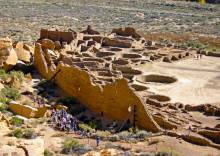Long-standing dispute about North American prehistory
 Posted date: 06 Jun 2019
Posted date: 06 Jun 2019
Pavel Flegontov,CSc. (University of Ostrava, Czech Republic) and his team have recently published an article in Nature that intends to put an end to a long-standing dispute over North American prehistory combining data and knowledge from paleogenetics and linguistics.
Paleogenetics is a rapidly developing scientific discipline at the junction of archaeology and genetics. Due to the rapid progress in the methods of sequencing DNA extracted from ancient bones, as well as in the methods of genetic data analysis, archeogenetics is becoming an integral component of research in human prehistory. However, the study of relatively recent history (the last 5 thousand years) by methods of archeogenetics is, oddly enough, methodologically difficult, despite the abundance of bone samples and their usually good preservation. As population density increased and means of transportation developed, mobility of people increased. And while in the long millennia of the Paleolithic a dominant pattern was genetic isolation of small groups of hunters, then from the beginning of the Neolithic migration and population micture became increasingly common. Thus, in order to clarify genetic history of virtually any region, it is necessary to unravel a very complex network of population splits and mixtures, i.e. a graph.
An example of such a complex region is Chukotka and the American Arctic - the vast expanses of tundra and Arctic desert, inhabited by sparse groups of Chukchi, Eskimos, Aleuts, and Inuit. For the first time the tundra zone of Alaska, the Canadian Arctic islands and Greenland was populated by so-called Paleo-Eskimos. This process began about 5,000 years ago with a migration of a small group of caribou, muskox and seal hunters across the Bering Strait. Then a succession of several archaeological cultures culminated in modern Eskimos, Aleuts and Inuit. However, archaeology very rarely can find whether the change in material culture was accompanied by mass migration and population replacement, or these were primarily cultural processes. Therefore, for decades, there have been controversies about the history of the Arctic peoples, about the relationship of Paleo-Eskimos and Inuit, as well as about the interaction of Paleo-Eskimos and native Americans who occupied the forests of Alaska and Canada adjacent to the tundra.
Posted By

GSP Admin




